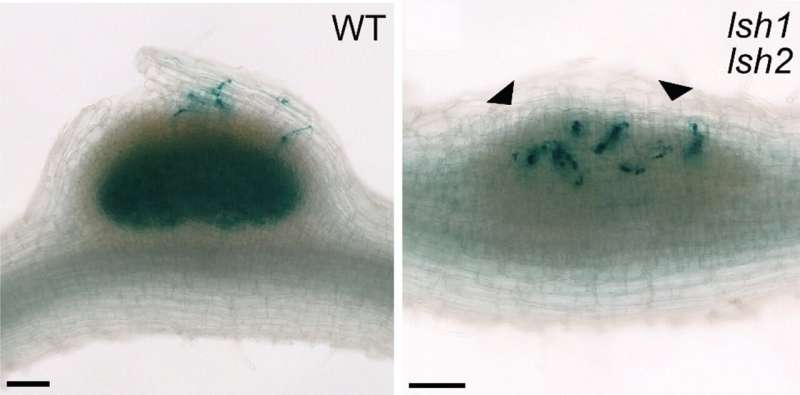LSH1/LSH2 are required to make nodules an infectable and habitable organ for rhizobial bacteria: Confocal image of WT and lsh1/lsh2 roots 24 and 72 hpi with S. meliloti (n > 30 per genotype and time point). The root was spot-inoculated with Sm2011 imaged at 72 hpi. Sm2011-mCherry bacteria in red, cell walls in white (fluorescent brightener), and EdU-labeled nuclei indicating DNA replication in green. Credit: Current Biology (2024). DOI: 10.1016/j.cub.2024.01.018
Cambridge scientists have identified two crucial genetic factors needed to produce specialized root organs that can accommodate nitrogen-fixing bacteria in legumes such as peas and beans.
In a surprising twist, the developmental regulators that confer the identity of these organs—known as nodules—belong to a transcription factor family more commonly associated with defining the shapes of stems, flowers and leaves. These factors are broadly conserved in plants, indicating their nodule-specifying function in legumes is a more recent innovation.
This significant discovery brings us one step closer to potentially engineering non-legume cereal crops like wheat, rice and maize to develop root nodule organs to host nitrogen fixing bacteria and reduce our reliance on industrial nitrogen fertilizers produced via the energy-consuming Haber Bosch Process.
This latest research, led by Dr. Katharina Schiessl, a Career Development Fellow at the Sainsbury Laboratory Cambridge University (SLCU), builds on her earlier findings that the same genetic program underlying lateral root development also underpins root nodule initiation.
Dr. Schiessl's discovery takes us a step further along the pathway of understanding how this symbiotic relationship is established between beneficial soil bacteria and legumes and how it is maintained to support biological nitrogen fixation. With the discovery that legumes are recycling genetic programs that are used by many species of plants, including cereals, the engineering task could be a whole lot less complicated.
Published in Current Biology, "Light-sensitive short hypocotyl genes confer symbiotic nodule identity in the legume Medicago truncatula", was a collaboration among scientists working at SLCU, the Crop Science Centre, John Innes Centre, University of Freiburg, Oklahoma State University and Royal Botanic Gardens, Kew.
Loss of LSH1/2 leads to a severe reduction of fully colonized nodule primordia: Images of WT and lsh1/lsh2 nodule primordia at emerged primordia stage observed 7 days post spray inoculation with rhizobial bacteria expressing LacZ (blue stain). Black arrowheads indicate infection threads that are restricted in their progression into the inner root tissue layers. Credit: Current Biology (2024). DOI: 10.1016/j.cub.2024.01.018
Their research identified two genetic factors, named LIGHT-SENSITIVE SHORT HYPOCOTYL (LSH1/LSH2), promote the production of specialized root cells that are required to make the developing nodule structure a suitable home for the nitrogen fixing bacteria—conferring nodule organ identity.
"We show two members of the LIGHT SENSITIVE SHORT HYPOCOTYL (LSH) transcription factor family are functioning as regulators of nodule organ identity," Dr. Schiessl said. "LSH1/LSH2 enlist a program in a root tissue called the cortex that facilitates the formation of a group of cells that are infectable and habitable by the bacteria early during nodule development. At the molecular level, this involves inhibiting the default lateral root program, controlling the dynamics of the plant hormones auxin and cytokinin, and promoting the expression of the previously identified key nodule organ identity regulators NODULE ROOT1/2 and Nuclear Factor Y-A1."
More information: Tak Lee et al, Light-sensitive short hypocotyl genes confer symbiotic nodule identity in the legume Medicago truncatula, Current Biology (2024). DOI: 10.1016/j.cub.2024.01.018
Provided by University of Cambridge
























